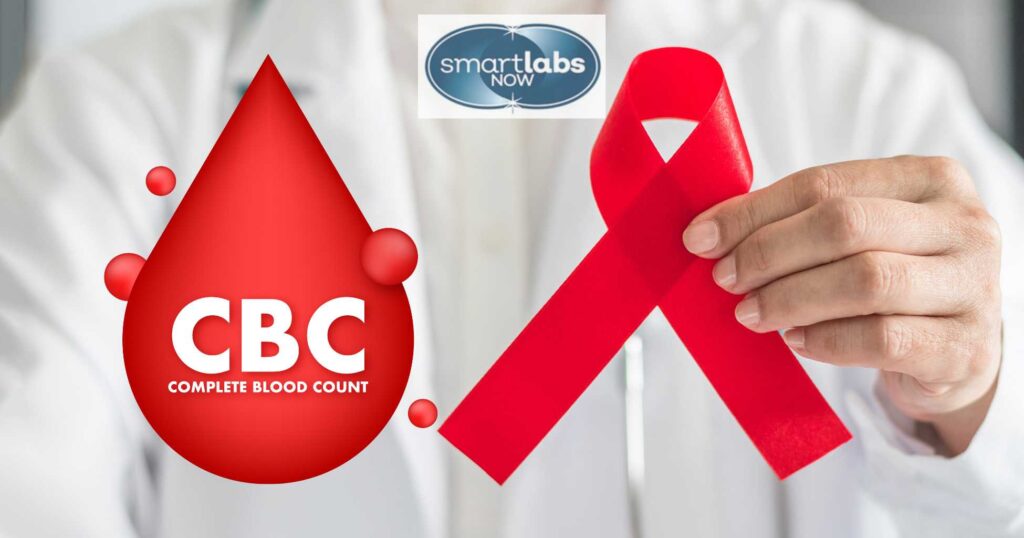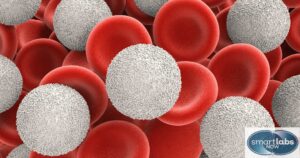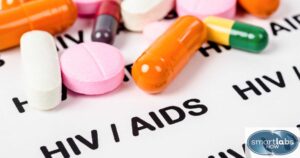
HIV, or Human Immunodeficiency Virus, is a serious condition that weakens the immune system by attacking important cells that help the body fight infections. Without treatment, HIV can progress to AIDS (Acquired Immunodeficiency Syndrome), making individuals vulnerable to other diseases.
Early virus detection is essential for improving health outcomes, and blood tests play a vital role in identifying infection early.
This article explores the potential signs of HIV in a Complete Blood Count (CBC) test, explaining what these results may indicate and how they relate to disease progression.

A Complete Blood Count (CBC) is a common and crucial test used to assess overall health. It measures several key components in the blood, including:
CBC tests are often part of routine health check-ups and can help monitor for various conditions, including infections, anemia, and blood disorders.
For HIV patients, regular CBC tests are particularly important because they provide insight into how well the body’s immune system is functioning and can indicate potential complications related to infection.

A CBC test is a versatile diagnostic tool that can reveal general signs of infection. When the body encounters an infectious agent—whether bacterial, viral, or fungal—it initiates an immune response, which often produces noticeable changes in blood cell counts and properties.
Below, we explore the main CBC indicators that can suggest an immune system response to infection.
One of the primary indicators of infection is an increase in the white blood cell (WBC) count. White blood cells are the body’s defense against foreign invaders. When a CBC shows elevated WBCs, it can indicate that the immune system is actively fighting off an infection. This response is common in bacterial infections but can also occur with viral and other diseases.
The specific types of white blood cells elevated in a CBC can also offer clues to the nature of the infection. For example:
An increase in monocytes may indicate a longer-lasting infection or a chronic inflammatory response. Monocytes are often elevated in cases where the immune system is responding to a persistent pathogen, such as tuberculosis or certain fungal infections. Elevated monocytes can also suggest that the body is in a recovery phase following an acute infection.
Although platelets are primarily involved in blood clotting, elevated platelet counts can occasionally accompany infection as part of the body’s inflammatory response. This is more common in chronic infections or inflammatory conditions where the immune response is prolonged.
In severe infections or chronic inflammatory conditions, changes in RBC indices, such as Mean Corpuscular Volume (MCV) or Mean Corpuscular Hemoglobin Concentration (MCHC), may occur due to inflammation affecting red blood cell production. For example, chronic infections can lead to anemia or inflammation, where red blood cells are smaller or fewer in number.
A CBC can serve as a first line of defense in identifying the need for further testing. By highlighting the body’s immune response, it offers a window into the body’s fight against infection and helps guide clinicians in the next steps for diagnosis and treatment.

While a CBC test monitors overall health, specific STD tests are required to detect HIV. The most common of these include:
Each test type has a different “window period,” which refers to the time between potential exposure to HIV and the test’s ability to detect the virus. Understanding these differences helps in choosing the most appropriate test and timing for detection.
Understanding how HIV is transmitted and identifying the associated risk factors are crucial steps in preventing the spread of the virus and promoting public health awareness.
HIV is primarily transmitted through the following routes:
Engaging in unprotected sexual activities, including vaginal, anal, and, less commonly, oral sex, with an infected individual can lead to HIV transmission.
The risk varies depending on the type of sexual activity, with receptive anal intercourse carrying a higher risk compared to other forms.
Significant exposure to infected body fluids or tissues, such as through contaminated hypodermic needles or blood transfusions, can result in HIV transmission.
HIV can be transmitted from an infected mother to her child during pregnancy, childbirth, or breastfeeding.
Without treatment, the risk of transmission before or during birth is around 20%, and in those who also breastfeed, it increases to 35%.
However, antiretroviral treatment can decrease this risk to less than 5%.
Several factors can increase the likelihood of HIV transmission:
Certain demographic groups are disproportionately affected by HIV:
In regions like the United States, a significant proportion of new HIV diagnoses occur among MSM.
African Americans and Hispanics represent a substantial percentage of new HIV infections, highlighting the need for targeted prevention and education efforts within these communities.
To mitigate the risk of HIV transmission, several preventive measures are recommended:
By comprehensively understanding HIV transmission routes and associated risk factors, individuals and communities can implement effective strategies to prevent new infections and manage existing cases.
Undergoing HIV testing can elicit a wide range of emotional responses, including anxiety, fear, and denial.
The anticipation of the test result often leads to significant stress, as individuals grapple with the potential implications for their health and future.
These emotions are natural and underscore the importance of addressing the psychological aspects of HIV testing.
The uncertainty surrounding an HIV test result can cause considerable anxiety. Concerns about stigma, health deterioration, and the impact on personal relationships contribute to this fear.
Some individuals may struggle to accept the possibility of an HIV-positive result, leading to denial. This defense mechanism can delay seeking necessary medical care and support.
Anticipating or receiving an HIV-positive diagnosis may lead to feelings of isolation.
The fear of being judged or discriminated against can cause individuals to withdraw from social interactions, exacerbating loneliness.
Professional counseling provides a safe space to express fears and concerns.
Counselors can offer coping mechanisms and emotional support, helping individuals navigate the complexities of HIV testing and diagnosis.
Joining support groups connects individuals with others facing similar challenges.
These groups offer empathy, shared experiences, and practical advice, fostering a sense of community and reducing feelings of isolation.
Understanding HIV transmission, treatment options, and living with the virus can alleviate fears. Accurate information empowers individuals, dispelling myths and reducing anxiety.
Engaging with healthcare providers ensures access to medical advice and emotional support.
Healthcare professionals can guide individuals through the testing process, interpret results, and discuss next steps.
Addressing the emotional aspects of HIV testing is crucial for overall well-being. Emotional support aids in processing the diagnosis, adhering to treatment, and maintaining mental health.
Healthcare providers should integrate emotional support into HIV testing and treatment protocols, ensuring individuals receive comprehensive care.

As mentioned, a CBC alone cannot diagnose HIV, as it does not directly test for the virus.
However, abnormalities in blood cell counts can suggest an underlying infection or immune system issue, prompting further HIV-specific testing.
If HIV is suspected, healthcare providers will typically order an HIV-focused test, like an antigen/antibody or NAT, to confirm the diagnosis.
Regular screening is important, especially for individuals with known risk factors or symptoms.

During the early stages of HIV infection, also known as acute HIV infection, individuals may experience flu-like symptoms, such as fever, fatigue, and swollen lymph nodes. During this phase, changes in blood counts can be detected, which may include:
– Decreased white blood cells: The virus attacks the immune system, leading to lower levels of certain white blood cells.
– P24 antigen blood test: This test detects an HIV protein called p24, which can be present shortly after infection.
– HIV RNA viral load test: This test measures the amount of HIV RNA in the blood. A high viral load indicates active HIV replication, often during the acute phase.
In cases of potential exposure, post-exposure prophylaxis (PEP) is available. It’s a medication taken after suspected exposure to HIV, reducing the risk of infection if started within 72 hours.

A CBC test provides a snapshot of an individual’s overall health and immune system function. In people living with HIV, deviations from normal CBC ranges may indicate disease progression or complications.
Here are the normal ranges and what deviations may mean in an HIV context:
White blood cells are central to the body’s defense against infections. In HIV:
Here’s some sense of the numbers:
The CD4 cell count is also crucial in HIV monitoring, as the virus specifically targets these immune cells. A low CD4 count indicates weakened immunity and higher vulnerability to infections.
The immune system comprises various cell types, including B cells and T cells (subtypes of white blood cells called lymphocytes). In HIV, T cells—particularly CD4+ T cells—are directly targeted and depleted, weakening the immune response. B cells are also affected indirectly, as T-cell dysfunction impacts B-cell regulation, leading to impaired antibody production and vulnerability to infections. Monitoring these cells provides essential insight into HIV’s impact on immune health.
T-cell tests are commonly used to assess HIV progression. A CD4+ T-cell count is a crucial marker, indicating immune function and helping determine the stage of HIV infection. Low CD4+ counts suggest a higher risk of opportunistic infections, such as cytomegalovirus (CMV). Regular T-cell testing is essential for tracking the virus’s effects and guiding treatment decisions.
Individuals with HIV are more susceptible to opportunistic infections like cytomegalovirus (CMV), a viral infection that can cause complications, especially in those with low T-cell counts.
Ganciclovir is an antiviral drug often used to treat CMV in HIV-positive patients, helping to manage the infection and reduce related symptoms.
Red blood cells (RBCs) are vital in transporting oxygen throughout the body. The normal range for RBC count is 4.7 to 6.1 million cells/µL for men and 4.2 to 5.4 million cells/µL for women.
In patients with HIV, a low RBC count, or anemia, is a common complication, particularly as the disease progresses. This can occur due to a variety of factors, including:
Anemia in HIV patients can lead to symptoms such as fatigue, dizziness, and shortness of breath, impacting their overall quality of life.
Normal platelet range: 150,000 to 450,000 platelets/µL.
In HIV patients, a low platelet count, known as thrombocytopenia, is common and can lead to easy bruising or bleeding, as platelets are essential for blood clotting. Thrombocytopenia is frequently observed in HIV and can serve as an indicator of disease progression or complications.
On the other hand, a high platelet count, or thrombocytosis, is less common but may occur in certain inflammatory conditions associated with HIV.
Monitoring platelet levels is crucial in tracking the effectiveness of HIV treatment and managing potential complications.

Undergoing HIV testing can be an emotional experience, often accompanied by anxiety, fear, or even denial. It’s normal to feel uncertain, but there are coping strategies to help manage these emotions:
– Counseling and support groups: Provide emotional support and reduce feelings of isolation.
– Healthcare provider support: Talking to a doctor about concerns helps reduce stress.
Whether the result is positive or negative, it’s important to have support in place. After a positive diagnosis, connecting with a healthcare provider is key to starting treatment and developing a care plan. After a negative result, regular testing may still be necessary if ongoing risk factors are present.

Beyond CBC, other critical HIV-related tests include:
– Viral load tests: Measure the amount of HIV in the blood and help monitor how well treatment is working.
– CD4 cell count: Reflects the immune system’s strength.
– Resistance testing: Determines if the virus is resistant to certain HIV medications, guiding treatment choices.
– Pre-exposure prophylaxis (PrEP): Medication taken to prevent HIV infection.
– Post-exposure prophylaxis (PEP): Discussed above; taken after potential exposure to reduce the chance of infection.

Early detection of HIV and regular monitoring through blood work are essential for managing the virus and maintaining health. While CBC tests can reveal important signs of HIV progression, they are not definitive for diagnosing the infection.
HIV-specific tests, like antigen/antibody and viral load tests, are needed to confirm and track the virus. If you suspect exposure or are experiencing symptoms, seek guidance from a healthcare provider for testing and support.
Early intervention and treatment can significantly improve long-term health outcomes.
If you’re in Portland, connect with us – we’ll safely get you tested right away 👍.
Please consult your primary care physician before engaging with any pharmaceutical, natural substances, or activity regimens mentioned or prescribed in this post. Smart Labs Now is not responsible for any health or life outcomes resulting from the use of the information or recommendations provided. This account does not serve as a substitute for professional medical advice.